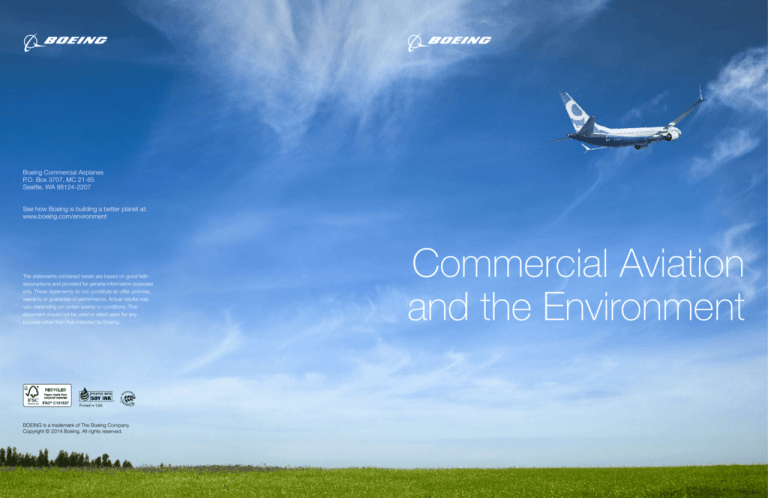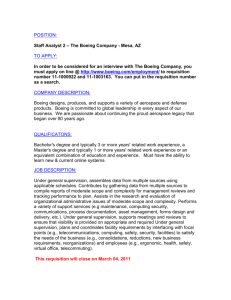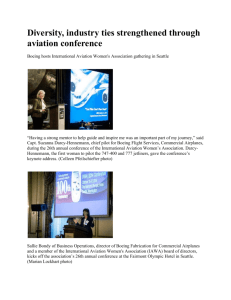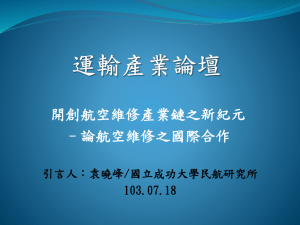
Boeing Commercial Airplanes
P.O. Box 3707, MC 21-85
Seattle, WA 98124-2207
See how Boeing is building a better planet at:
www.boeing.com/environment
The statements contained herein are based on good faith
assumptions and provided for general information purposes
only. These statements do not constitute an offer, promise,
warranty or guarantee of performance. Actual results may
vary depending on certain events or conditions. This
document should not be used or relied upon for any
purpose other than that intended by Boeing.
BOEING is a trademark of The Boeing Company.
Copyright © 2014 Boeing. All rights reserved.
Commercial Aviation
and the Environment
Cover image:
Boeing 737 MAX 9
Air Travel and
Sustainability
Table of contents
Aviation’s focus on environment is good for business and the planet
Air Travel and Sustainability............1
More Efficient Airplanes.................3
Efficient Operations........................5
Sustainable Aviation Biofuel...........7
Boeing ecoDemonstrator...............9
Aircraft Recycling.........................11
Cleaner Operations......................13
Commercial aviation is poised for
tremendous growth, as technology
and economic growth are making
air travel more accessible to people
around the world.
To meet this increasing demand,
Boeing is designing and building
more advanced products. Airlines
are investing in more fuel-efficient
airplanes, opening routes and
improving service. And when aviation
expands, it generates trade, tourism
and further economic growth.
Air travel is fuel efficient
2.6 - 10.9 Liters
Boeing also understands that
commercial aviation needs to grow
sustainably. At Boeing, 75 percent of
research and development funding
supports greater environmental
performance in our products,
services and operations.
1.5 - 5.7 Liters
2.1 - 4.2 Liters
Predominantly
diesel-powered
2.1 - 2.4 Liters
More Fuel
Efficient
2-class
Predominantly
electric-powered
Internal Combustion Car
Train
1-class
Electric Car
737 MAX 8
Equivalent liters of fuel per 100 passenger kilometers.
1 | Air Travel and Sustainability
This investment helps meet aviation’s
environmental goals and its business
needs. Simply put, using less fuel
reduces greenhouse gas emissions
and helps customer profitability at a
time when jet fuel can account for
more than 40 percent of an airline’s
operating budget.
Aviation has long been focused on
efficiency, a trend that will continue.
Airplanes today – which are 70
percent more efficient than Jet Age
models – are far more efficient than
most cars, trucks and many trains.
The 787 Dreamliner uses 20 percent
less fuel than the airplane it replaces.
Flying on the new 737 MAX will
be comparable even to driving an
electric car (see graphic).
Boeing continues to look
for opportunities to improve
sustainability through an airplane’s life
cycle, from design and production to
flight operations and end-of-service
recycling. That includes:
»» Bringing to market the world’s
most fuel-efficient airplane
family – 737 MAX, 747-8, 787
and 777X – and services that
improve gate-to-gate efficiency.
»» A Design for Environment
philosophy that sets ambitious
targets and embeds tools into
the design process to improve
Boeing airplanes’ environmental
performance.
»» Working with many stakeholders
to advance our industry’s
environmental progress,
including commercialization of
sustainable aviation biofuel.
»» Investing in programs, such
as the ecoDemonstrator, that
accelerate testing and use of
new technologies.
»» Aggressive goals to improve
our facilities’ environmental
performance.
Today’s airplanes
are far more efficient
than most cars and
trucks - and this
trend will continue.
Looking ahead, Boeing is
committed to further our industry’s
environmental stewardship
through continued innovation
and global engagement. Our
customers, industry, employees and
communities deserve nothing less.
Air Travel and Sustainability | 2
Factory
Efficiency
More Efficient
Airplanes
To meet a record-setting pace of
airplane deliveries, Boeing and its
employees continually look for ways
to make factory production more
efficient with Lean+ techniques.
These processes drive quality into
production, reduce cost and time
and deliver significant environmental
benefits, from reducing waste to
saving energy. Here are some
examples:
Market leadership with the world’s most fuel-efficient products
Boeing is providing the world’s
most efficient airplanes to serve
our customers and help meet our
industry’s environmental goals.
When airplanes use less fuel, airlines
reduce their costs and greenhousegas emissions. When airplanes are
quieter, it reduces noise in local
communities.
Looking to the future, Boeing is
investing billions of dollars to design
and build a new generation of
products made with lighter materials,
improved aerodynamics, more
efficient engines and technologies
that increase our customers’
operational efficiency.
When airplanes use
less fuel, airlines
reduce their costs
and greenhousegas emissions.
The 747-8 Intercontinental and
Freighter are prime examples,
3 | More Efficient Airplanes
improving fuel efficiency – and
reducing emissions – by 16 percent
compared to the airplanes they
replace. Today’s Queen of the Skies
features advanced engines, a new
wing and advanced materials for
better performance with a smaller
environmental footprint.
The single-aisle 737 MAX will be
the most fuel-efficient airplane in
its class. With deliveries starting
in 2017, this airplane’s improved
aerodynamics and engine efficiency
will give the airplane an 8 percent
per seat operating cost advantage
over its competition.
Design updates, including Boeing’s
Advanced Technology winglet with
natural laminar flow technology, are
unique to Boeing and significantly
enhance the aerodynamic efficiency
of the 737.
»» To reach 47 airplanes a month
in 2017, when the 737 MAX
enters service, the 737 program
is taking a Lean+ approach to
reconfiguring existing floor space
to add a third production line to
Boeing’s Renton, Wash., factory.
Boeing 787-9 Dreamliner
The 737 MAX will be 14 percent
more fuel efficient than today’s NextGeneration 737, with a 40 percent
smaller community noise footprint.
»» The efficient 737 line improved
processes to ramp up from 31.5
airplanes per month in 2010 to
42 airplanes per month in 2014.
At a Lean+ workshop, teams
identified 15 major improvements
in the 737 assembly.
Boeing’s use of composite materials
also adds significantly to airplane
performance. The 787 Dreamliner
has revolutionized the industry: With
a composite
fuselage, sleek
composite wing
and advanced
engines, the
Dreamliner is 20
percent more fuel
efficient than similarly
sized aircraft.
The 777X,
with deliveries starting
in 2020, will be the largest, most
efficient twin-engine airplane in the
world.
New engines and a composite wing
design will ensure the 777X remains
the most fuel-efficient commercial
airplane in its category: 12 percent
more efficient than its competitor.
»» The 777 program produces 8.3
airplanes per month, up from 5
per month in 2010. Employees
often contribute new ideas to
eliminate rework and waste,
improving safety, quality and flow
time of 777 final assembly.
»» One team asked the company to
develop a tool called a “paddle
fitting jig” to help drill cleaner,
straighter holes in hard-to-reach
areas. The result: Angle-free,
perfectly matched holes, faster
production and savings of
thousands of dollars per airplane.
More Efficient Airplanes | 4
Reducing fuel
consumption
in today’s fleet
Efficient Operations
To improve efficiency and reduce
emissions for in-service airplanes,
Boeing develops Performance
Improvement Packages (PIP)
that measurably reduce fuel
consumption.
Leveraging new technologies for gate-to-gate efficiency
The PIP program was launched in
2008 when the price of oil reached
$150 a barrel, a serious threat to
profitability in the airline business.
Today, operators realize tremendous
savings by multiplying Boeing’s
performance improvements across
their existing fleets.
To save fuel and time and reduce
greenhouse-gas emissions from
gate to gate, Boeing has developed
valuable technologies that make
flight operations more efficient
and help address environmental
regulations. Boeing is offering these
technologies as part of the Boeing
Edge, the company’s portfolio of
services that provide customers with
a competitive advantage.
Examples include:
»» The 747-8 PIP increased
efficiency by 1.8 percent with
updates to the airplane’s GEnx2B engines. These improvements
mean that operators will use
30 fewer trucks of jet fuel per
airplane per year.
»» The Next-Generation 737
PIP combined aerodynamic
and engine performance
improvements to reduce fuel
consumption by up to 2 percent.
This can save more than
$120,000 annually in fuel costs
per airplane.
5 | Efficient Operations
The results are tangible for airlines
and the aviation industry. Trimming
all flights by one minute would save
airlines $1.5 billion per year in fuel
costs and reduce carbon dioxide
emissions by 4.8 million tons (4.35
metric tons) annually, according
to the International Air Transport
Association.
The Boeing Edge portfolio includes
new digital products and data
services for pilots on the flight deck.
The Boeing Edge portfolio includes
new digital products and data
services for pilots on the flight deck.
With easy-to-read images and realtime data, these digital solutions
reduce pilot workload, reduce
fuel consumption and emissions,
increase situational awareness and
lower costs for operators.
One example is a mobile application
developed by Jeppesen, a Boeing
subsidiary, that replaces a pilot’s
paper charts, reducing weight by as
much as 50 pounds per pilot. Others
are the Boeing Fuel Dashboard and
Boeing Emissions Reporter, which
monitor fuel consumption, identify
fuel savings opportunities and track
and report carbon emissions.
Digital subscription services such
as Wind Updates and Direct Routes
allow pilots to make adjustments en
route based on current weather and
air traffic conditions.
Using Boeing-developed algorithms,
these services support more efficient
trajectory prediction during preflight
and continuous optimization in flight
by providing tailored information
for flight crews and airplane flight
management systems.
Boeing also works with customers to
improve efficiency during landings.
Boeing’s Required Navigational
Performance reduces noise and fuel
use and improves accessibility to
airports in challenging terrain.
Boeing continues to advocate
for accelerating modernization of
the global air traffic management
system, which could boost efficiency
for all airplanes flying by as much as
12 percent.
Boeing Edge
digital solutions
save fuel and
time and reduce
greenhouse-gas
emissions and
costs.
In countries and regions around
the world, Boeing partners
with governments, airlines,
the International Civil Aviation
Organization and other stakeholders
to continuously improve system-wide
efficiency, with a goal to reach 95
percent efficiency by 2025 and 98
percent efficiency by 2050.
Efficient Operations | 6
Sustainability
is key
Sustainable
Aviation Biofuel
Boeing biofuel projects meet broad
goals for sustainability: Reducing
net greenhouse-gas emissions,
supporting socioeconomic
development and avoiding adverse
effects to local food security, fresh
water and land use.
Regional biofuel efforts supported
by Boeing utilize principles
established by the globally
recognized Roundtable on
Sustainable Biomaterials (RSB) to
evaluate sustainability based on
several criteria. Advanced biofuel
feedstocks are non-food crops
that typically require less land and
proportionately less fertilizer and
water. They also are exponentially
more efficient and more sustainable
sources of energy than firstgeneration feedstocks.
Significant progress toward a new fuel for aviation
Boeing is proud of its leadership
role in working with partners around
the world to develop sustainable
aviation biofuel. Renewable jet fuel
is essential to achieve commercial
aviation’s environmental goals and
reduce its reliance on petroleum.
When produced sustainably, aviation
biofuel reduces carbon emissions
by 50 to 80 percent compared with
petroleum Jet A through its life cycle.
Since aviation biofuel was approved
for commercial use in 2011, airlines
have flown more than 1,500 flights
with a blend of biofuel and fossil
Sustainable aviation
biofuel reduces
CO2 emissions by
50 to 80 percent
compared to Jet A
through its life cycle.
7 | Sustainable Aviation Biofuel
fuel. Our industry’s challenge is to
increase the global supply and bring
down the price of biofuel to meet
strong demand from airlines.
Boeing is committed to meet
this challenge by collaborating
with airlines, engine companies,
governments, researchers and
others to advance sustainable
aviation biofuel supply chains
around the world. Our company’s
aggressive goal is that before 2016,
the supply of sustainable aviation
biofuel will address 1 percent –
about 600 million gallons – of global
jet fuel demand, leading to increased
market acceptance and investment.
Boeing is focused on “drop in”
biofuels that perform as well as or
better than petroleum and can be
blended directly with Jet A without
changing airplanes, engines or the
fueling infrastructure. Our projects
also meet stringent standards for
sustainability to ensure they support
environmental and community goals
(see sidebar).
Currently Boeing supports biofuel
projects around the globe, including
in Australia, Brazil, China, Europe,
Japan, the Middle East, Southeast
Asia, Southern Africa and the United
States. These explore a wide variety
of feedstocks, from used cooking
oil and agricultural waste to algae,
halophytes, camelina and jatropha,
among others.
Our current projects include:
»» In the U.A.E., Boeing partners
with Etihad Airways to support
research at Masdar Institute
of Science and Technology on
halophytes, desert plants that
can be irrigated with seawater.
We also actively pursue approvals
for new types of aviation biofuel. In
a breakthrough that could rapidly
expand supply for our industry,
Boeing discovered that “green
diesel,” a truck fuel made from oils
and fats, is chemically similar to
currently approved aviation biofuel.
With global production capacity of
800 million gallons, green diesel is
price competitive with petroleum
jet fuel, including government
incentives. Boeing is now working
with the U.S. Federal Aviation
Administration and other key
stakeholders to approve this fuel for
use in commercial aviation.
Boeing collaborates with
stakeholders around the world to
develop sustainable aviation biofuel.
»» In Southern Africa and
Southeast Asia, we work with
airlines and RSB to expand
ways for farmers with small plots
of land to tap into demand for
sustainable feedstocks.
»» In China, Boeing and the
Commercial Aircraft Corp. of
China (COMAC) collaborate to
efficiently produce biofuel from
waste cooking oil, also known as
“gutter oil.”
Sustainable Aviation Biofuel | 8
Boeing
ecoDemonstrator
Accelerating the testing and use of new technologies
The Boeing ecoDemonstrator 787 Flight Test Airplane
Improving sustainability through an airplane’s life cycle
737
2012
787
2013
2014
757
2015
2016
2017
20XX
The Boeing ecoDemonstrator Program is testing a different suite of environmentally progressive
technologies each year for the next several years.
9 | Boeing ecoDemonstrator
The Boeing ecoDemonstrator
Program is a great example of the
company’s investment to speed
development of technologies that will
make our aircraft cleaner, quieter and
more fuel efficient.
Using ecoDemonstrator flight test
airplanes – including a 737, 787
Dreamliner and 757 – Boeing
works with key stakeholders to
improve sustainability across an
airplane’s life cycle, from design
and manufacturing to in-service
operation and retirement. The
ecoDemonstrator Program is testing
a different suite of environmentally
progressive technologies each
year for the next several years (see
graphic).
The program focuses on items that
decrease fuel use, reduce noise,
lower global and local emissions,
improve in-flight operations and
decrease the use of energy and
other resources.
In this effort, Boeing partners with
selected suppliers, airlines and
government agencies, including
NASA and the U.S. Federal Aviation
Administration’s Continuous Lower
Energy, Emissions and Noise
(CLEEN) program. Our shared
goal is to test, refine and complete
technologies ranging from alternative
energy sources to advanced
components that directly improve
fuel efficiency.
ecoDemonstrator
speeds
development of
technologies that
make our aircraft
cleaner, quieter
and more fuel
efficient.
The ecoDemonstrator’s inaugural
flight in 2012 tested a range of
innovations on an American Airlines
Next-Generation 737-800. They
included assessments of natural
laminar flow, a technology that will
be incorporated into the 737 MAX
Advanced Technology Winglet
design to make this fuel-saving
feature even more efficient.
The 2012 ecoDemonstrator also
tested a regenerative hydrogen fuel
cell to provide cabin power and
advanced flight trajectory and in-flight
planning software to enable more
direct and efficient routes.
In 2014, a Boeing 787 will test a
ceramic matrix composite nozzle
on the engine that allows for higher
combustion temperatures, leading
to better fuel efficiency. The program
will also sample greenhouse gases
in the atmosphere during flight for
later analysis.
Boeing’s 757 ecoDemonstrator
flight test airplane, which will take
to the skies in 2015, has already
completed initial testing of lightweight
interior sidewall panels to reduce
noise. The airplane will also assess
an active flow control on the vertical
tail aimed at reducing weight, a
system to reduce environmental
noise and wireless technologies that
can reduce weight, fuel and power
consumption on Boeing aircraft.
Boeing ecoDemonstrator | 10
Aircraft Recycling
Increasing opportunities to reduce waste after airplanes are retired
With airlines purchasing more fuelefficient airplanes to reduce costs,
Boeing has estimated that the
industry will retire more than 8,000
aircraft from the current global fleet
over the next decade. Ensuring
that retired aircraft can be recycled
and disassembled responsibly is a
key element in Boeing’s life cycle
approach to environmental design.
We work with partners to expand
the reuse of parts and materials in
airplanes being retired today. We
also work with industry and research
institutions to develop technologies
that will more efficiently recycle
advanced carbon composites in a
new generation of airplanes.
In 2006, Boeing was a founding
partner of the Aircraft Fleet Recycling
Association (AFRA). AFRA, the
leading global organization focused
on promoting environmental best
practices for aircraft disassembly,
offers best-practice guides and
accreditation for safe, sustainable
aircraft dismantling and parts reuse.
Airplane carpet, which is replaced
20 to 30 times over an airplane’s
lifetime, is another focus area. To
reduce waste sent to landfills and
make it cheaper and easier for
customers to replace soiled carpet,
Boeing is testing nylon modular
carpet tiles. They are easy to replace
when needed and can be recycled
into new carpet tiles.
Boeing wants to
expand reuse of
parts and
materials in
airplanes retired
today and decades
from now.
Boeing is also exploring methods
to recycle composites in airplanes
leaving service decades from now.
This is important as we increase the
use of composites in airplanes such
as the 787, which is 50 percent
composites by weight, and the 777X.
Recycled fiber is already used to
make parts for cars and electronics
and sports equipment. Our longterm goal is significant “closed
loop” recycling of carbon fiber into
aerospace industry parts.
Boeing cooperates with University
of Nottingham in the United
Kingdom, BMW, ORACLE TEAM
USA and other partners to refine
recycling processes. Boeing also
looks for future opportunities to
recycle composite scrap from
787 production. The Boeing
ecoDemonstrator Program will test
a wing access door made from
recycled carbon fiber.
Boeing’s long-term goal is significant
“closed loop” recycling of carbon
fiber into aerospace industry parts.
11 | Aircraft Recycling
Aircraft Recycling | 12
Boeing is accelerating improvements
in environmental performance of
the company’s operations, even as
our commercial production rates
continue to grow. We are committed
to zero growth in greenhouse-gas
emissions, water use and solid
waste to landfill through 2017, based
on our history of performance.
Boeing is increasingly using
sustainable energy sources and
incorporating energy conservation
into our operations.
»» Boeing relies on carbon-free
hydroelectric and renewable
energy sources for nearly half of
total electricity consumption.
»» Carbon-free hydroelectric energy
supplies more than 80 percent
of the power for Boeing’s Everett
and Seattle facilities.
»» The 787 final assembly building
in North Charleston, South
Carolina, is powered by 100
percent renewable energy,
sourced from 10 acres (4.05
hectares) of solar panels on the
roof and coupled with renewable
energy credits purchased from
the local utility.
»» Since 2011, Boeing has earned
the ENERGY STAR Partner
of the Year award from the
U.S. Environmental Protection
Agency.
13 | Cleaner Operations
Improvements in Boeing’s
environmental performance are
the result of innovative projects at
facilities across the globe.
Boeing Commercial Airplanes
delivery centers in Everett,
Wash., and South Carolina have
received Leadership in Energy and
Environmental Design (LEED) Gold
certification from the U.S. Green
Building Council. In Salt Lake City,
Utah, Boeing’s LEED Silver-certified
program switched to rechargeable
batteries in headlamps for their
work sealing wing fuel tanks. The
team now uses 400 rechargeable
batteries a year – compared to
50,000 disposable batteries reducing waste by 16,000 pounds
(900 kilograms) annually.
Cleaner Operations
Sustainable energy sources, efficient buildings, employee involvement
Boeing is
increasingly
using sustainable
energy sources
and incorporating
energy conservation
into our operations.
paint facility for the 787-9 horizontal
stabilizer is heated partially with solar
energy collected by solar tubes on
the building’s roof. LEED standards
include lower energy and water use,
natural lighting and use of recyclable
and locally sourced materials.
Employee involvement is crucial to
achieving Boeing’s environmental
commitments. Among many
examples, a team on the 787
The 787 final assembly
building in South Carolina
is powered by 100 percent
renewable energy sources.
Cleaner Operations | 14







